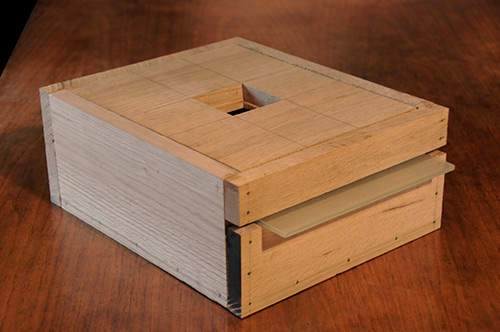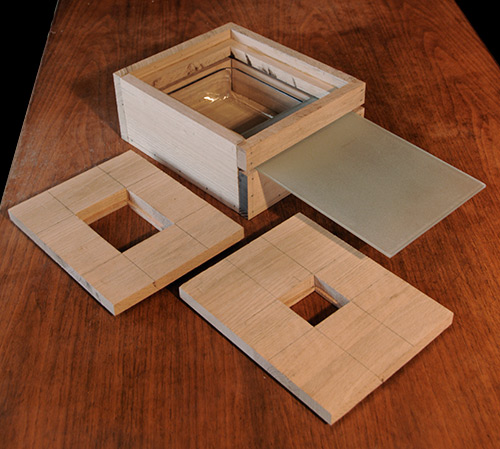Archive for the 'Daguerreotypy' Category
The Met, Bisbee, and the Quest for Rubylith
This past weekend I took a quick trip to New York. While I was there I happened to see Framing a Century: Master Photographers, 1840–1940, a special exhibition at The Met. While it was a fascinating show and I saw lots of beautiful albumen and salted paper prints, there was an unfortunate lack of daguerreotypes. Perhaps I missed them or they were in another room but I was a little disappointed…
On the plane I managed to finish reading A. Bisbee’s The History and Practice of Daguerreotyping (1853). It’s a short book of a little over 100 pages that contains Bisbee’s methods and opinions of the daguerreotype process as well as a couple short essays on heliochromy (naturally colored daguerreotypes) and the collodion process (wet plate, ambrotype, tintype, etc.). He is much more succinct (and opinionated) in his description of the process than Humphrey. It might be easier for someone starting out to read this work before embarking on Humphrey’s hand book. The history component is interesting but I don’t think it’s all that accurate, though I’m no authority. It does, however, say that the ‘lavender’ light I found so funny was termed by Sir John Herschel (p. 23).
For the past couple of weeks I’ve been on the quest for rubylith. I figured I could just pick some up in town but that was unfortunately not the case. A couple of the people I asked said ‘what in the world to you need that old stuff for?!?’ and one person got all teary-eyed and nostalgic over their long lost rubylith days. I finally resorted to buying a roll off ebay. So if anyone needs rubylith, I’ll have plenty soon.
Comments are off for this postMr. Humphrey and the Silver Sunbeam
I have just finished S. D. Humphrey’s American Hand Book of the Daguerreotype (1858) (available for free from Project Gutenberg). As everyone knows and states quite often: this book is utterly devoid of safety. On page 81, Humphrey states (with one of the few cautionary asides):
If by accident (we would not advise a trial to any extent of this), you should inhale a quantity of the vapor of bromine, immediately inhale the vapor of aqua ammonia, as this neutralizes the dangers effects of the bromine vapor.
Now admittedly I’m not medically or chemically savvy enough to say with any authority whether this method would work; to me it just sounds like a bad idea.
Once you get past the lack of safety and, really, the lack of knowledge that a lot of the chemicals were actually dangerous, the book is a must read. A must read for daguerreotypists anyway. Even though a lot of the procedures he uses can be replaced with mechanical means or require extra considerations of safety, there is a pile of information that allows one to fine tune and troubleshoot the process as well as whet their appetite for experimentation. Once I start using mercury development it would be great to try some of the formulas he describes for preparing the ‘quick’.
There is also a chapter on light and optics. The mid 1800s concept of light is more limited from ours now but it’s fascinating to read their perspective. They knew that daguerreotypes were sensitive to blue light and a light beyond the blue which they called lavender. For some reason (perhaps it’s the physicist in me) I found this endlessly funny! Lavender light!?! Now I’m sure the information was dumbed down quite a bit for the audience but still, I found it funny.
Anyway, the book has a lot of interesting insights and ideas. It is worth the read or even just to have around as a reference. This book probably contains most of the final ‘best practices’ of the art before it rapidly went into decline in the 1860s. In a book I recently picked up, J. Towler’s The Silver Sunbeam (1864), the daguerreotype process is confined to a mere 4 pages out of the 330+ pages describing photographic processes. Only 6 years after Humphrey’s hand book and the daguerreotype process is barely more than a footnote. However, it does have this to say about the process (p.268):
Comments are off for this postThe Daguerreotype
A photograph on a silver or silvered plate is superior in definition and beauty to all other photographs taken on other materials.
Fuming Box, check.
I have finished building my fuming box! It’s certainly not pretty but I think it’ll work well. I made two tops for it: one for 2 1/4″ square plates and the other for quarter plates. I have a medium format camera and a 4×5 press camera so I should be able to shoot both of those plate sizes.


I learned a lot building this box and I’m looking forward to tackling the other pieces in the daguerreian puzzle. Perhaps the fume hood will be next.
As of now, here is a list if things I have for making daguerreotypes:
Chemicals
- Iodine Crystals (from Photographers’ Formulary)
- Sodium Thiosulfate (from Bostick & Sullivan)
- Sodium Sulfite (from Bostick & Sullivan)
- 0.2% Gold Chloride Solution (from Bostick & Sullivan)
Equipment
- Dedicated “Dag Back” for my medium format camera (from KEH)
- Fuming Box!! (from my own hands)
Other Supplies
- 2 3/8″ Square .999 Silver Plates (from Santa Fe Jewelers Supply)
- Filmoplast P90 (from Talas)
As far as I can tell, I still have the following left to get:
- Rubylith
- Buffing Wheels
- Buffing Compound
- Small Trays
- Gilding Stand
- Gilding Lamp/Torch
- Small Fume Hood